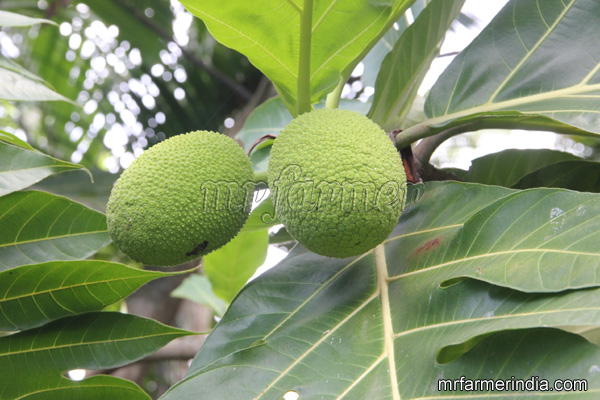Artocarpus altilis “breadfruit”

Artocarpus altilis is an important fruit vegetable tree grown in the homesteads of southern part of India. The multipurpose trees are easy to grow, beneficial to the environment, and produce an abundance of nutritious, tasty fruit. They also provide construction materials, medicine, fabric, glue, insect repellent, animal feed, and more. The trees begin bearing in 3 to 5 years and are productive for many decades. An evergreen tree (12-15 m up to 21 m), breadfruit tends to have a denser, more spreading canopy. Leaves (15-60 cm or longer) are almost entire to deeply dissected with 1-6 pairs of lobes Fruit (10-30 cm long × 9-20 cm wide) vary in shape, size, and skin texture. They are usually round, oval or oblong weighing 0.25-6 kg. Skin texture ranges from smooth to rough to spiny. The color is light green, yellowish-green or yellow when mature, although one unusual variety. The flesh is creamy white to pale yellow. Fruit are typically mature and ready to cook and eat as a starchy staple in 15-19 weeks. Ripe fruit have yellow or yellow-brown skin and soft, sweet, creamy flesh that can be eaten raw or cooked. Fruit contain zero to many seeds depending upon the variety. Seeds are rounded or obovoid, irregularly compressed, 1-3 cm long and with a pale to dark brown seed coat. Seeds germinate immediately and cannot be dried or stored. They are rarely used for propagation. Breadfruit is usually vegetatively propagated using root shoots or root cuttings. Breadfruit is a versatile crop and the fruit can be cooked and eaten at all stages of maturity. It is an important staple food in the Pacific region, parts of the Caribbean and other tropical regions where it is mainly grown as a subsistence crop in home gardens or small farms. It is an excellent dietary staple commonly eaten in the tropics, Carbohydrates are the main source of energy with low levels of protein and fat and a moderate glycemic index. It is a good source of dietary fiber, potassium, calcium, and magnesium with small amounts of thiamin, riboflavin, niacin and iron. Some varieties contain small amounts of folic acid. Yellow-fleshed varieties can be a good source of provitamin A carotenoids.
